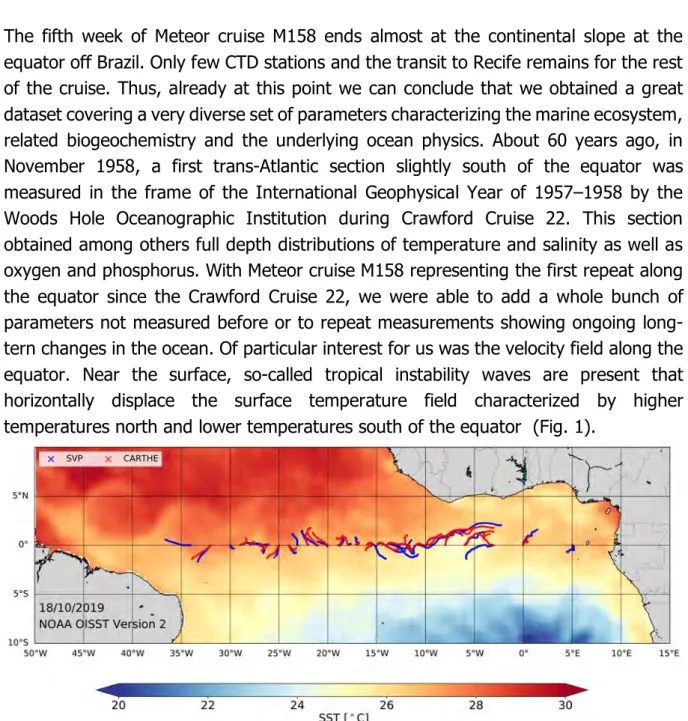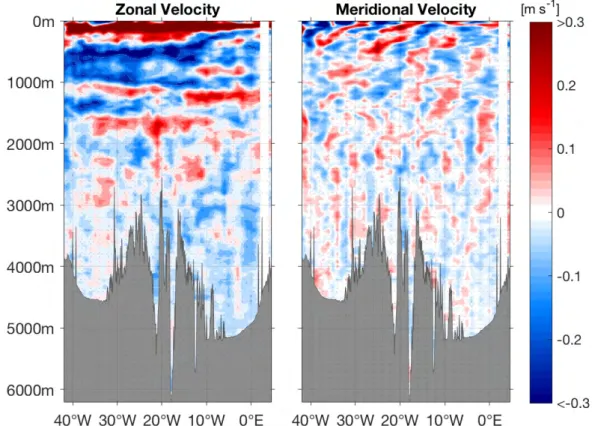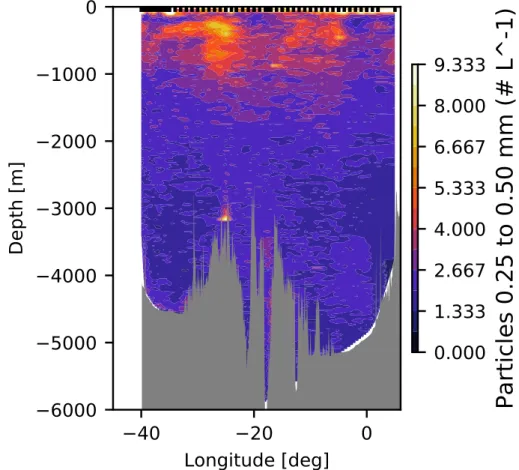Prof. Dr. Peter Brandt Meteor cruise 158
5
thWeekly Report M158, Walvis Bay-Recife
Oct. 14 - Oct. 20, 2019
The fifth week of Meteor cruise M158 ends almost at the continental slope at the equator off Brazil. Only few CTD stations and the transit to Recife remains for the rest of the cruise. Thus, already at this point we can conclude that we obtained a great dataset covering a very diverse set of parameters characterizing the marine ecosystem, related biogeochemistry and the underlying ocean physics. About 60 years ago, in November 1958, a first trans-Atlantic section slightly south of the equator was measured in the frame of the International Geophysical Year of 1957–1958 by the Woods Hole Oceanographic Institution during Crawford Cruise 22. This section obtained among others full depth distributions of temperature and salinity as well as oxygen and phosphorus. With Meteor cruise M158 representing the first repeat along the equator since the Crawford Cruise 22, we were able to add a whole bunch of parameters not measured before or to repeat measurements showing ongoing long- tern changes in the ocean. Of particular interest for us was the velocity field along the equator. Near the surface, so-called tropical instability waves are present that horizontally displace the surface temperature field characterized by higher temperatures north and lower temperatures south of the equator (Fig. 1).
Fig. 1: Sea Surface Temperature (SST) on October 18, 2019 and surface drifter paths. SVP drifter represent velocity in 15 m and CARTHE drifter velocity in 1 m. The drifters move north- or southward away from the equator in association with the phase of the tropical instability waves (Arthur Prigent).
Shipboard velocity measurements typically are possible from about 20 m below the ship to about 1000 m. The missing upper 20 m close to the surface are, however, important for upper ocean mixing, heat, freshwater, and trace gas budgets as well as for near surface biological productivity. To address this observational gap, we deployed different types of drifters, i.e. CARTHE drifter drifting nominally with the water in the
Prof. Dr. Peter Brandt Meteor cruise 158
upper meter and SVP drifters drifting with waters in 15 m. They were both deployed along the equator with a one-degree resolution and nicely show the alternating north- and southward velocities of the tropical instability waves. The drifter motions will evolve during the next few months, but already show strong deviations between 1-m and 15-m velocities. Additionally, an X-band radar that was installed at the beginning of the cruise is aimed to measure surface velocity due to the effect of surface currents on surface waves. The analysis of this dataset will be done later at home.
One of the main goals of the cruise was to measure the full depth velocity field along the equator. This was done by combining the two shipboard ADCPs with the lowered ADCPs attached to the CTD rosette. The obtained zonal velocity is characterized by basin-wide jets transporting water along the equator from one side of the ocean to the other. Strongest flow of more than 1 m/s eastward is found in the core of the Equatorial Undercurrent near the surface. However also at large depth east- and westward velocities of up to 30 cm/s are observed (Fig. 2). Such remarkable variability is missing in state-of-the-art ocean models resulting in errors of simulated temperature or tracer fields. The meridional velocity shows north- and southward flow alternating along the equator with a wavelength of about 1000 km. These waves are generated near the surface and propagate their energy downward thereby driving the basin-wide deep zonal flow.
Fig. 2: Zonal and meridional velocity component as measured with the LADCP. The equatorial ocean is very energetic also at large depths (Philip Tuchen).
The primary productivity in the equatorial Atlantic is one of the key features of tropical ocean biogeochemistry. It fuels a substantial flux of particulate matter towards the
Prof. Dr. Peter Brandt Meteor cruise 158
abyssal ocean, which is often called equatorial snowfall. Up to now measurements of particles were only made along a few meridional, cross-equatorial transects showing high particle concentrations near the equator. During M158, we measured the first section of particle distribution along the equator showing high particle concentrations near the surface, particle maxima at around 300 m depths, generally decreasing particle numbers with depth and locally near-bottom particle maxima (Fig. 3). The maxima at 300 m depth are found to be associated with vertically migrating zooplankton that avoid the near-surface predation during the day. The particle distribution will be analyzed in comparison to data from an ultra-deep Acoustic Zooplankton and Fish Profiler also installed at the CTD rosette. With its acoustic measurements, the distribution and the biovolume of fish and zooplankton can be determined up to 36 m away from the CTD. Here, too, we have acquired a complete dataset across the Atlantic to a depth of 6,000 meters. Additional regular casts with a plankton net complement these measurements.
Fig. 3: Abundance of particles along the equator as measured by the Underwater Vision Profiler 5 attached to the CTD rosette. Particles are generally produced near the surface and sink into the abyssal ocean (Rainer Kiko).
Next weekend, we are already in Recife. On Saturday, the day of our arrival, there will be a reception on the occasion of the 50th anniversary of the bilateral cooperation on science, technology and innovation organized by German BMBF and embassy. During that event as well as for groups of visiting Brazilian pupils and students, we have the
Prof. Dr. Peter Brandt Meteor cruise 158
chance to provide some insight into the diverse marine research that is possible on this great research vessel. On Monday, a large part of the scientific crew will participate on the Seminar of the bilateral cooperation DOCEAN – GEOMAR. This is already the 7th seminar in this series highlighting the long-term excellent cooperation between Brazil and Germany in marine research.
At this point we would like to thank captain Detlef Korte and his crew for the great support in all areas and their important contribution to the success of the cruise, which was of course only possible due to the great commitment of all scientists and technicians. Thanks for the great time we had onboard!
Greetings from the tropics in the name of the cruise participants of M158, Peter Brandt
GEOMAR Helmholtz Centre for Ocean Research Kiel


